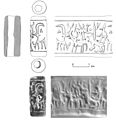El-Ahwat
El-Ahwat is a settlement discovered by Adam Zertal (1936–2015) in 1992 and excavated between 1993 and 2000, near Qazir and the West Bank border, east of Caesarea in Israel . According to the Bible, the settlement, which dates back to the Bronze and Iron Ages , is the location of the northwesternmost settlement of the Israelites.
According to Zertal, the architecture is reminiscent of the late Bronze Age nuraghi sites on Sardinia . It connects the place with the Shardana of the 12th century. Zertal dates the site to 1160–1150 BC. BC which corresponds to the invasion of the Sea Peoples in Israel and the conflict between Sisera and Barak ben Avinoam, ruler of the judge Debora (judges 4–5). Zertal points out that it is the city of Harosheth Haggoyim (the Haroschet of the Gentiles), which is mentioned in the Book of Judges as the residence of Sisera of the general Jabins , king of Hazor . A charioteer found claims that the location may be a residence of weight.
- El-Ahwat
literature
- Israel Finkelstein : El-Ahwat: A Fortified Sea People City? in Israel Exploration Journal 52 (2002), 187-199.
- Israel Finkelstein, E. Piasetzky: Radiocarbon Dating and Philistine Chronology, with an Addendum on el-Ahwat, in: Egypt and Levante 17 (2007), 173–182.
- Adam Zertal (Ed.): El-Ahwat: A Fortified Site from the Early Iron Age Near Nahal 'Iron, Israel. Excavations 1993-2000. (= Culture and History of the Ancient Near East , Volume 24). Leiden 2011. ISBN 978-90-47-42989-0 , doi : 10.1163 / ej.9789004176454.i-488
Web links
Coordinates: 32 ° 29 ' N , 35 ° 6' E



